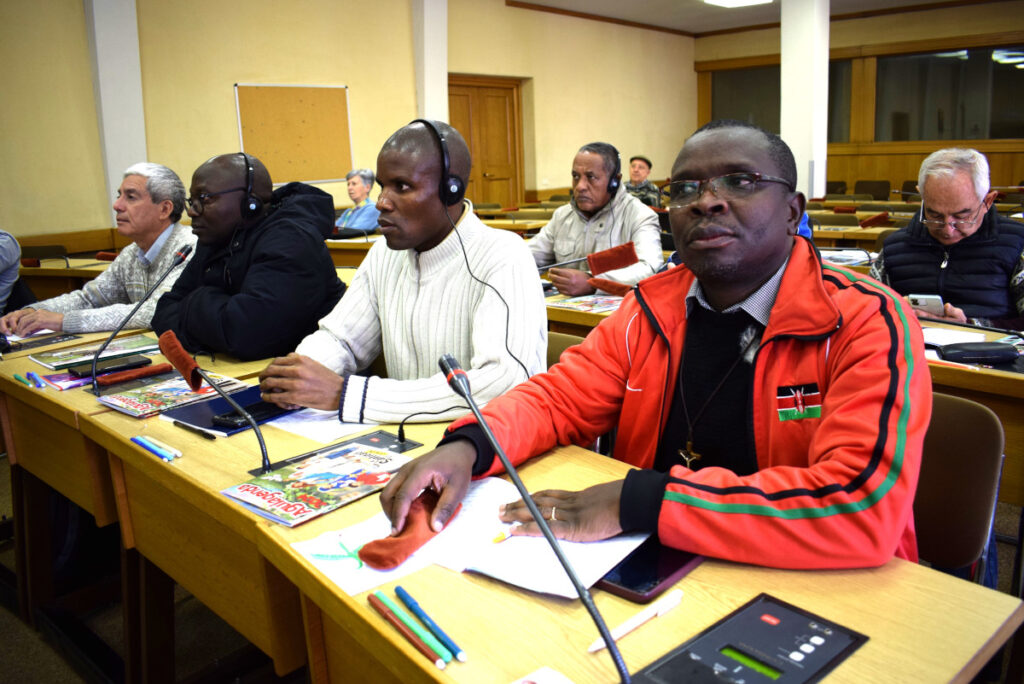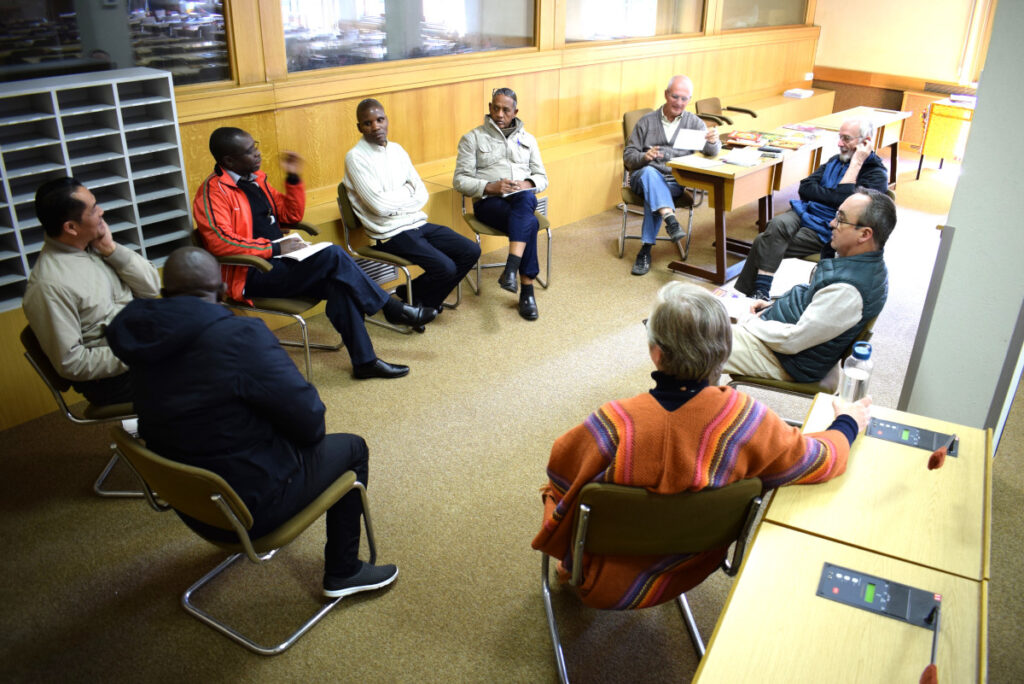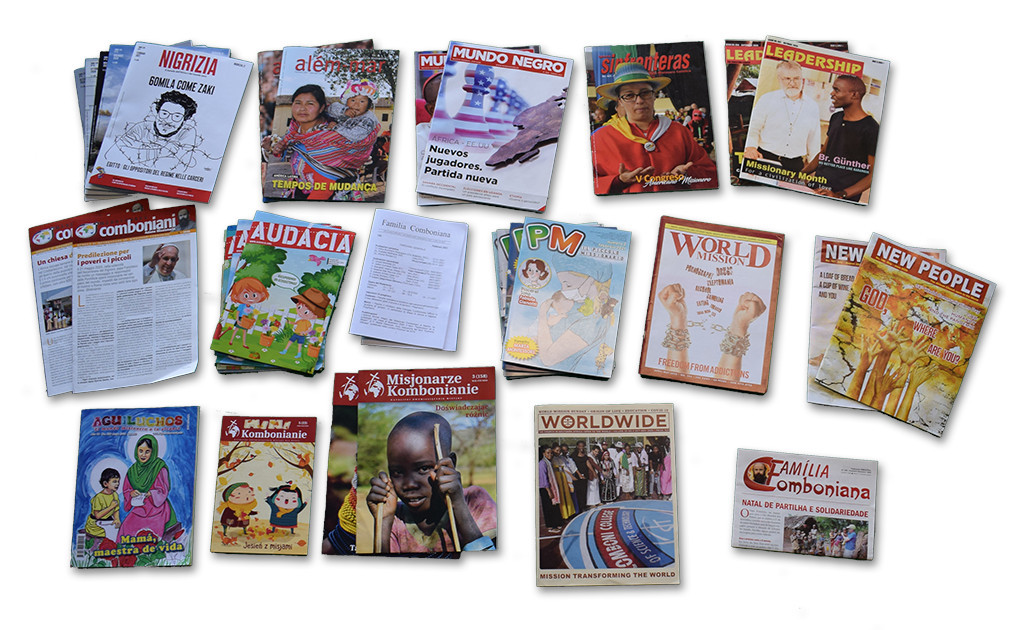By General Secretariat of Mission
The General Assembly of Missionary Animation took place in Rome from 22 to 26 April, with the participation of sector leaders (from 21 circumscriptions), continental referents and observers of the Comboni Family.
Acknowledging the epochal changes that are taking place, the XIX General Chapter had given a mandate to carry out an assessment of Missionary Animation (CA ’22, 32). This assembly, therefore, was an opportunity to make this assessment and to reflect together on the present and future of Missionary Animation (MA) with a gaze marked by hope, aware that it does not help to complain about what does not work or is no longer practicable, but instead it is necessary to recognize both what is effective and the emerging paths of a MA guided by the Spirit of the Lord.
These are the specific objectives of the Assembly:
take stock of the Institute’s Missionary Animation.
- rethink and take a view of AM in the context of the profound epochal changes that are taking place.
- revitalising MA through concrete proposals adapted to the times,
- initiate continental paths of collaboration in MA.
Looking to the future with hope
From the photograph of MA in the Institute it emerges that the situation, far from being homogeneous, is very varied depending on the context. In general terms, there are characterizing trends at the continental level.
In Europe, a process of updating has been underway for some time that integrates MA and evangelization, overcoming the geographical paradigm of mission, in which MA was seen mainly as support for the mission overseas. This does not mean abandoning the activities that have characterized this service in the past but developing them according to a broader and more up-to-date perspective, in the wake of collaboration between the Churches outlined by the Second Vatican Council.
In America-Asia, historically evangelization and MA have been co-present and, therefore, there is less difficulty in interpreting MA according to an integrated model.
In Africa, on the other hand, although there are some well-established experiences of MA, this is a field that has yet to be developed and with great untapped potential.
The current challenges of AM depend mainly on the epochal changes underway that affect both the socio-cultural and ecclesial realities. Thus, for example, both the growth of young Churches in the Global South and the decrease in the Global North have an impact on MA, albeit in the opposite direction. By changing the physiognomy and ecclesial dynamics, the MA of the local Churches must also change in order to reposition itself in the new contexts that are being created. The temptation could be to allow oneself to be disturbed by the changes, since, for example, in the circumscriptions of the North there is a significant decrease in vocations, benefactors and a significant presence on the territory, while, in those of the global South, considerable difficulties are experienced in involving the participation of Christian communities – and of the local Churches in general – in the mission, including financial support.
In reality, however, we realize that we are facing a “new missionary springtime”, in a world that is transforming with a rapidity never seen before. Looking to the future with hope, therefore, means looking at reality with a gaze capable of grasping the novelties that the action of the Spirit is infusing into reality. In other words, we are called to understand “the signs of the times”, which are not events as such or social conditions in themselves, but the relationship they have about the Kingdom of God. The MA today must grasp these signs to seek the places where God’s action can be expressed as salvation, to support and promote it.
The digital revolution, with the new mass media and social networks, is displacing us, as it requires skills that, in general, we have not yet acquired. It’s not just about the technological aspect, but about the profound cultural change that all this implies. We are dealing with a different way of communicating, which refers to a new paradigm of communication. The world of communication is now considered as the “sixth continent” to be evangelized.
Yet, in the face of the new and exciting challenges of MA, we encounter serious difficulties within the Institute both in terms of the employment and training of staff in this field, and in terms of the systematic organization of the service. On all this, a change of pace is needed, investing more staff and preparing them for this service. But it is also necessary to grow in the awareness that every missionary is a missionary animator starting from the ministry assigned to him and that every community is called to be a centre of missionary animation and spirituality.
There is a need for a systematic organization of this ministry, which aims at planning and collaboration at all levels and at the involvement of various pastoral forces and agents. All this requires adequate and up-to-date preparation, which is often difficult to offer, given the lack of AM schools.

An up-to-date view of AM
An up-to-date vision of AM can only start from Pope Francis’ apostolic exhortation, Evangelii Gaudium, which states that “missionary action is the paradigm of every work of the Church” (EG 15). Francis wants a Church that “goes forth”, that bears witness to “the joy of the Gospel”, starting from the existential and geographical peripheries, putting itself on the side of the poor. Every ecclesial reality is called to live the mission, both with the direct proclamation of Christ and with the promotion of the unity of the human race and of universal peace, because the Church grows by attraction and not by proselytism (cf. EG 14).
In this perspective, the boundaries between evangelization, missionary, and vocation animation, and JPIC are no longer as clear as they once were, when the mission was framed in a geographical paradigm. If the mission is the proclamation of the Gospel and the promotion of the values of the Kingdom, the purpose of MA is to be a stimulus to the Church and to society to defend life in all its dimensions (CA ’09 n.180.2). The MA cannot, therefore, address only the Catholic world.
Moreover, in today’s context, mission and missionary animation must be seen in the line of collaboration between the Churches, stimulating mutual knowledge and sharing of the riches and diversities of the universal Church; the prophetic denunciation of all injustice and oppression; the formation of pastoral agents and of the people of God so that they may be protagonists of transformation.
MA, in particular, consists in communicating the passion for the mission: it is nothing more than “giving life to the mission”. It is not an activity of marketing or recruitment of human resources, but the ability to involve one’s Church in the universal mission.
As far as the field of action is concerned, the AM is concretely based on five cornerstones:
- missionary spirituality,
- critical information,
- missionary formation,
- solidarity,
- vocation promotion.
There must therefore be a dialectic between collaboration and the service of missionary animation in the local Church – through diocesan structures and programmes – and the specific contribution of Comboni missionary animation.

Opportunities to relaunch MA
While it is an undeniable fact that the rapid changes, we are experiencing are creating difficulties for our commitment to MA, it is also true that these same transformations are offering us interesting opportunities for a revival of our commitment to this ministry.
An example on which the Assembly reflected is that of integral ecology, in which the XIX General Chapter identified a “fundamental axis of our mission, which connects the pastoral, liturgical, formative, social, economic, political and environmental dimensions” (CA ’22, 30). Obviously, when we say integral ecology, we are not referring only to the natural environment, but to the totality of all the dimensions of reality (social, economic, political, cultural, spiritual, etc.). In today’s context, in fact, six important repercussions of integral ecology on MA are emerging:
- The dissolution of the boundary between missionary animation and evangelization – Experience on various continents shows us the difficulty of distinguishing these two dimensions. For example, the work with migrants in Europe and the work for peace in Latin America is a commitment to the evangelization of people on the margins and to the missionary animation of Christian communities in the territory.
- The opportunity of an effective starting point to reach those who are far away – We note that the issues related to integral ecology are a great opportunity to relaunch our territorial presence in environments far from the Church or indifferent to her. There are various positive experiences in this sense: awareness-raising programs in schools, the development of Laudato si’ paths, participation and support in youth initiatives, contexts of intercultural and interreligious dialogue.
- Becoming a bridge between different worlds in view of the Kingdom – Integral ecology requires combining the local and global dimensions, situations, and actors of the North with those of the South of the world. These are dimensions that are difficult to meet, in an increasingly polarized world. MA becomes an important factor in the unity of the human family in view of the Kingdom of God, through denunciation, the proposal of an alternative world, the involvement and collaboration between different and distant actors, and the encounter of peoples.
- A Broader Dimension of Missionary Prayer – Prayer is a fundamental aspect of mission, especially if it gives rise to new paths in view of the Kingdom. A significant experience was that of the prayer campaign in the run-up to and during the COP28 climate summit, held in Dubai in December 2023. In the line of Pope Francis’ Apostolic Exhortation Laudate Deum, which called on world leaders to show courage and authentic ecological conversion, Christian communities were invited to accompany the process with intense prayer, in the awareness that God can touch human hearts and consciences.
- The materialization of new forms of support for the mission – We are entering an era in which the support of benefactors from the Global North is coming to an end. Missionary animation aimed at evangelizing the economy – through the development of cooperatives and social enterprises, for example, while promoting economic self-sufficiency, social justice, and environmental sustainability – can generate opportunities to support missionary ministry. But there is also the possibility of opening our community structures and making them open and available for the purpose of integral ecology. We have various experiences in this sense, which while making our presence in the area relevant and prophetic, make the management of our facilities sustainable.
- The development of pastoral programs on integral ecology – It is found that often the dimension of integral ecology and the social magisterium of Pope Francis are not included in pastoral programs, or do not find concrete application outlets. Therefore, it is necessary to develop and promote programs based on the methodology of the “pastoral cycle”, with the aim of sensitizing Christian communities to integral ecology – in the light of the Word of God and the Magisterium of the Church – to integrate it into their journey of faith, and to make them protagonists in the process of ecological conversion.

The BOND of communication and the digital world
The Institute has always been involved in the field of communication through missionary magazines. Today, the Institute publishes 24 publications, 7 of which are dedicated to children and young people. It is an impressive commitment and publishing reality, which today must deal with socio-cultural and communicative changes that require new languages and skills. Most of the circumscriptions have developed initiatives in the digital world, through websites, social networks, radio programs and other communication and cultural initiatives. However, there are still very much scattered actions: there are great possibilities for collaboration, sharing of materials and skills, and coordination at the continental level still to be tested. The challenge is twofold: on the one hand, there is the issue of the inadequacy of the staff working in this sector, both from the quantitative point of view and from the qualitative point of view of skills and specializations. On the other hand, there is the aspect of systematic planning of this service and of giving continuity. For example, there is often a misalignment between discernment – for example, Chapter decisions – and planning in the circumscriptions. You need a solid communication plan and consistency in its implementation, programming for specializations, and robust collaboration at the continental level. This includes reciprocal cooperation in the planning and carrying out of missionary activities with the Comboni Family (FC), with the organizations of which we are members – such as Africa Europe Faith and Justice Network (AEFJN) and VIVAT International, or with ecclesial organizations such as REPAM, REBAC, CLAR, etc. – with the local Church, with other ecclesial and civil forces, and with the Comboni circumscriptions at the continental level, especially in the field of mission, missionary animation, editorial production and the dissemination of information through the media.
In the reflection of the groups, it was reaffirmed that Missionary Animation cannot be improvised and, therefore, to carry out this ministry well, it is necessary, among other things:
- to choose confreres and lay people prepared with professional competence, missionary passion, and a solid spirituality, capable of working and sharing information at the circumscription and continent level, in collaboration with the Comboni Family, other institutes and the local Churches;
- work in teams that have a communication plan for the various internal and external communication media, approved and accompanied by the circumscription superiors;
- to motivate the confreres and the Comboni communities to read, use and disseminate our means of communication and missionary animation.
- enhance all means, including digital ones, to create a loyal network of friends and benefactors.

Continental Paths
One of the objectives of the General Assembly of MA (AGAM) was to initiate continental paths and collaboration, because the relaunch of MA requires “creating a system”, creating synergies, sharing resources, experiences, skills.
Therefore, the Assembly worked in continental groups (Africa, America-Asia, Europe) and in a reflection group including the Comboni Family. Starting from what emerged during the course of the work and which questioned the participants with reference to their contexts, each group identified some shared paths to be taken and promoted to follow up on AGAM.
Concretely, collaboration initiatives have been proposed, starting with activities that currently appear to be priorities:
- In Europe, the focus is on the specific formation of missionary animators and on collaboration with the Comboni Family and other partners, especially lay people and young people. It is suggested to offer a course for missionary animators in Europe by 2025, to develop various skills in view of a relaunch of this service. It also aims to give visibility to collaborative initiatives as FC and to “celebrate”, and to promote a common project to CF in MA in each circumscription.
- In America-Asia, emphasis was placed on the development of the use of digital media and the preparation of Comboni personnel for this task. A more qualified collaboration of the work of MA at the level of circumscriptions and at the continental level is proposed, and it is suggested to prepare lay people and to involve them in communication, also to give more continuity to this service.
- In Africa, there are two collaborative initiatives proposed:
- the sharing of MA material, including the development of an animation website for each province;
- the organization at continental level of a training program in missiology and communication for MA.
Conclusion
Participants’ assessment of AGAM was largely positive. It emerged that, despite the diversity of situations and needs of the circumscriptions, all the participants found a satisfactory treatment of aspects that were significant for them, in an atmosphere of fraternity and mutual trust, which fostered a serene, frank and open dialogue in which each person expressed himself freely, felt welcomed and listened to by the group.
It was highlighted that the Assembly was not an event in itself, but a stage in a journey to be made together, which began with the preliminary elaboration of the mapping of the MA and opened to continental paths now to be proposed, initiated and accompanied.
Let us start again with enthusiasm and with the awareness of many possibilities to relaunch the MA service in the circumscriptions and continents.
Finally, we are pleased to share the summary booklet of the work of AGAM, to promote sharing and reflection on MA at the community, circumscription, and continental level.





